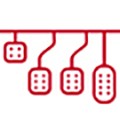They are the same brake. The terms are used interchangeably. Another term for an emergency brake is a hand brake as the brake next to the driver on the right side is operated by hand, where as the foot operated brake is on the lower left side under the dash area.
TYPES OF PARKING BRAKES
There are four main types of parking brakes that you may encounter:
Pedal – The pedal emergency brake is a small pedal that is positioned on the floor and to the left of the gas, brake and clutch pedals. Press down on the pedal until you hear it click to engage it. Pull the lever above the foot pedal to release the brake.
Center lever – Popular on late-model vehicles with bucket seats, this type of parking brake is found between the seats. Simply pull up the lever to engage the emergency brake. To release the brake, press the button on the end and push down on the stick.
Push button – Located with the other console controls, this typically is an electronic system. Engaging and releasing this type of parking brake is as easy as pushing the button on the console.
Stick lever – Found in many older vehicles, the stick lever emergency brake is commonly found under the instrument panel.










